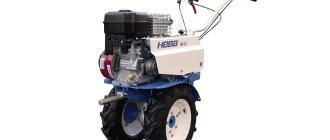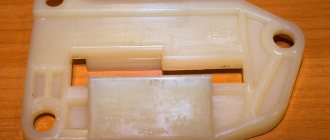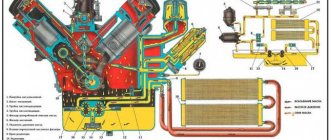Today, for a number of reasons, automatic transmission is a much more preferable option than manual transmission. This is especially true if the car is constantly used in a metropolitan area, where traffic in heavy traffic is characterized by low speeds, frequent accelerations and stops, as well as moving and idling in traffic jams.
Given this popularity, many novice drivers, as well as those who previously drove a car with a manual transmission, are actively switching to cars with an automatic transmission. Next, we will look at how to change gears on an automatic transmission, what you need to know about automatic transmission modes, and also how to engage reverse gear on an automatic transmission.
Manual transmission: sequence of actions
1. Under no circumstances try to engage reverse gear at high engine speeds. Structurally, the gearbox is designed in such a way that the synchronization of rotation of the gearbox gears is significantly worse than when engaging a gear to move forward. 2. Turning on moment. On different manual transmissions, the reverse mode can be activated differently. Perhaps the lever needs to be pressed down - without this the speed will not turn on. How to turn on reverse gear on your car - read in the car manual. General recommendations: do not try to apply significant force - this will inevitably lead to breakdown of the manual transmission. 3. Engine idle speed is the law. Set the car to the parking brake, press the clutch pedal, and engage reverse gear. Next, look carefully using mirrors; for beginners, it would be a good idea to turn the body and look around without the help of mirrors. Then everything is simple - start moving.
Second gear
Rice. 35. Second gear
From neutral, second gear is engaged in the same way as first gear. There is only one difference - the ball along the left corridor must be directed not forward, but backward. However, in practice, drivers of passenger cars rarely have to engage second gear from the neutral position; generally, the second gear follows the first (Fig. 35).
To switch from first gear to second without error, you need to perform three specific actions:
- Lightly press the ball against the left wall of the corridor (when it is still in the “hole” of the first gear) and hold it near this wall during subsequent actions (red arrows in Fig. 35);
- With a short movement, push the ball out of the “hole” of the first gear into a neutral position in the left corridor, without allowing the spring to move the ball into the right corridor (Fig. 35, position 0′);
- After a short pause in the neutral position 0′, move the ball along the left wall back to the end of the corridor and drop it into the “hole” of the second gear.
Do not change gear from first to second in one motion!
There are many reasons to pause in neutral. This is both the technical side of the matter (the work of synchronizers and gears in the gearbox), and moments for planning your next actions. And most importantly, you need to initially accustom your right hand to the correct actions, since all gears must be switched with a pause in the neutral position.
The second gear is turned off in the same way as the first, only the ball must be pushed forward, not backward. By the way, all other gears are turned off with the same movement, only some by moving the hand forward, and others backward.
Let's immediately formulate a rule on this topic:
To turn off any gear, you should make one specific, slight, short movement of your hand forward or backward.
Automatic gearbox: sequence of actions
1. On an automatic transmission, the reverse mode is usually indicated by the letter R. To engage reverse gear, simply move the lever to the appropriate position and start driving. 2. On an automatic transmission, it is worth taking into account the fact that, due to the design features, you can inadvertently engage reverse gear when moving forward. On new models there is a lock, but on older ones this is possible. Be careful - if this happens, the automatic transmission will fail. 3. For automatic transmissions, the same rules apply as for manual transmissions - switching occurs only at idle engine speed.
Fixing the problem
Let's look at several ways to help fix the problem with engaging reverse gear.
Backstage adjustment
Before you begin solving the problem, take with you everything you might need:
- new gearbox driveshaft;
- speed selector shaft oil seal;
- two ring wrenches 13;
- wrench 10;
- hammer;
- screwdriver.
Cardan and boot for VAZ 2109
New gear selector rod oil seal for VAZ 2109
Socket wrench 13
10mm wrench
Construction hammer for work
Flat head screwdriver
To fully replace the cardan, you will need to drive into a pit or overpass. In addition, you will need an assistant who will shift the gearbox lever while you adjust it.
Let's start replacing the cardan and adjusting the rocker:
- You need to crawl under the bottom of the 2109 and find your gearbox. Take two 13mm wrenches and loosen the clamp located on the transmission drive rod. After this, you can remove the drive from the gearbox mechanism rod.
- Then take a screwdriver and, with a little force, pull the boot closer to the unit. If you accidentally damage the boot, you can simply dismantle it so that it does not bother you. Now take a 10mm wrench and unscrew the locking screw on the cardan.
- Next, take a hammer and very carefully knock the gearbox driveshaft off the shaft. Do this carefully so as not to damage the shaft. Remove the cardan boot if you did not remove it initially. If necessary, replace the speed selector shaft oil seal.
- At this point we can consider that half the work has already been done. Now you need to install the driveshaft of the box. We install the element in the reverse order. First, install the new boot in place, and then place the cardan on the shaft. Remember that the position of the retaining screw must coincide with the recess on the shaft.
- When the universal joint is in place, tighten the fixing screw and install the boot on the universal joint. You also need to put the gear shift drive rod on the cardan rod, but there is no need to tighten the clamp.
- Next, you will need the help of another person, since you need to adjust the gearshift lever. Ask your assistant to sit in the driver’s seat: he should set the gearshift lever to “neutral” and move it slightly to the right. In this position, an assistant should hold the lever while you tighten the cardan clamp.
Loosen the drive rod clamp.
The boot is highlighted in red, which must be pulled towards the box using a screwdriver.
Place the drive rod onto the rod.
When the cardan adjustment is completed, you need to check how the speeds on the lever are switched on. If the problem that caused the reverse gear to not engage in your VAZ 2109 was in the cardan, which is most likely, then after replacing the element the fault should disappear.
Changing gearbox oil
Also, one of the common reasons why reverse gear in a VAZ 2109 does not engage is poor gear oil. As stated above, the liquid has already lost its properties and its further use does not make sense. But how do you understand that the transmission fluid has already exhausted its service life? This issue should be taken seriously, because the fluid replacement procedure is not that cheap. Therefore, you need to know for sure that the gear oil has lost its properties.
- Pull the dipstick out of the gearbox hole to measure the level and drop a drop of liquid onto a white cloth. If at least one of the following conditions occurs, change the oil immediately.
- The lubricating fluid is discolored and may have a slightly black tint. Also, even in a small drop of oil you can see metal particles or other dust.
- The transmission fluid is opaque and appears very viscous. If you try it by touch, the substance will stick to your hands. In addition, if you drop this oil onto a piece of cloth or napkin, it will be absorbed very slowly compared to new oil.
- Very cloudy or foamy liquid. This may mean that transmission oil has entered the engine. If so, then the problem with engaging reverse gear is the first thing you will notice. If the car continues to operate on poor transmission fluid, then it may be necessary to completely repair the gearbox and the entire transmission system.
Checking the TM level in the box using a dipstick
We recommend: How to choose alloy wheels for your car?
If you realize that the transmission fluid has already exhausted its service life, then, apparently, the time has come to replace it. Moreover, if the solution to the problem with engaging reverse gear depends on this. Prepare:
- New transmission oil (hereinafter referred to as TM). Please note that if your VAZ 2109 is equipped with a four-speed gearbox, then three liters of TM will be enough for you. If your car has a five-speed gearbox, then you will need 3.3 liters of consumables. For VAZ cars, it is recommended to use transmission fluid with a viscosity class of 80W-85. In practice, many VAZ car owners fill the checkpoint of their cars with Lukoil.
- Container for collecting waste consumables. An old bucket or basin will do. If there is neither one nor the other, then you can take a regular plastic water bottle and cut off its upper part.
- Set of wrenches.
Lukoil transmission fluid for VAZ 2109
Homemade container for collecting used transmission material
Wrenches and sockets
To carry out the work, you need to go into a garage with an inspection hole.
- Reach under the bottom of the car and locate the transmission fluid drain cap. It is located at the bottom of the gearbox unit.
- Find the rubber cap on the unit itself: it needs to be cleaned. Also clean the gearbox breather and reinstall the rubber cap.
- After this, you can start draining the waste liquid. Take a wrench and unscrew the drain cap of the gearbox unit. Before doing this, do not forget to place a container under the drain hole, prepared in advance for collecting waste consumables.
- Now you need to wait 20-30 minutes until all the “working off” has been drained. Please note that the car must be warmed up. If the temperature of the gearbox unit is not high, then the TM will be thicker and will not be able to completely leak out of the box.
- When all consumables have been drained from the gearbox, you can screw on the drain cap. Tighten it as tight as possible, but do not over-tighten it to avoid stripping the threads. After this, open the hood and find the dipstick to check the level of consumables from the gearbox. Pull it out and insert a hose into the hole, at the other end of which a regular watering can is installed. Fill with fresh TM.
- When pouring consumables into the transmission system, periodically check the level of the substance in the gearbox using a dipstick. Ideally, the TM level should stop midway between the MIN and MAX marks.
- When new oil is added, check its level in the gearbox just in case. It is also advisable to check the TM level after a few days. This is done in order to find out if there are leaks in the system.
Drain plug VAZ 2109
Remove the rubber cap and clean the breather
Unscrew the drain cover
Fill consumables through the dipstick hole
Filling an old-style gearbox with oil through a syringe
The red arrows indicate the filler and drain holes on the old-style gearbox
If your VAZ 2109 has an old-style gearbox installed, then it will not have a hole for the dipstick. But the drain and filler plugs will be located nearby. In general, the procedure is no different, only you will have to pour TM into the unit using a special syringe.
What to do if reverse gear does not engage
1. If noises and grinding noises are heard: turn off the engine and stop trying to turn it on - the gearbox or clutch has failed. The solution is to contact a specialist, or push the car out and drive to the nearest workshop, without engaging reverse gear. 2. If there are no extraneous sounds when you turn it on, but you can’t turn it on, try again, taking into account the characteristics of your car: perhaps you do not recess the lever, or do not move it to the side enough. And lastly: any actions to turn on the speed must be carried out with the clutch pedal depressed.
Cabin wires
When the fuse is fully operational, everything is in order with the plug, and the Kalina does not engage reverse gear, look at the switch located under the decorative cover near the gearshift lever itself. There are two wires connected to this switch. They are connected to each other. If the transmission started to turn on normally, then the reason was precisely in the switch.
You can measure the voltage on the wires using needles. There must be at least 12 V at the switch. If you don’t have a multimeter, you can measure the voltage using a light bulb. If it does not light up, this indicates a broken wire. This usually happens in the place where the clamp is installed on the pallet. This easily explains the question: why reverse gear does not engage on the Lada Kalina.
We recommend: Fuel filter: description, types, replacement, device, photo, video.
The clamp is removed and compressed at the bottom of the fastener. Next, disconnect the lamp switch connector. Then take out the entire tourniquet. The broken wire will be visible immediately. What to do next? The cord is connected to a piece of good wire - you can make a simple twist.
But it's best to solder the connection. Then everything is assembled in reverse order. If the transmission is engaged, then the problem is solved.
How to reverse with a manual transmission and drive with a manual transmission
To learn how to drive a vehicle with a manual transmission, you will need to make some effort to achieve this goal. Even if the first attempts are not successful, only practical training and a clear understanding of how to get used to a manual transmission allow you to improve your skills.
In this article, we will look at the basic principles of driving a manual car, how to properly drive a manual transmission, and how to engage the manual transmission in reverse.
When to switch
Switching should be smooth, but at the same time fast.
Many are rightly interested in when exactly it is necessary to switch from one speed to another. Although there are different cars and boxes, there are averages. Namely:
These numbers are approximate and average, as there are a number of other factors that affect driving.
The presented diagram is relevant for cars that are not loaded and move along the road without resistance in the form of sand, deep snow or steep inclines. If there is such resistance, then it is recommended to switch to the next gear a little later.
Motorists and driving instructors have developed a useful reminder that they recommend that a beginner remember. The bottom line is this:
You can also shift out of order if necessary, shifting from high to low to apply engine braking.
There are a number of visual videos on the Internet about how to properly operate the gearshift lever on a manual car. Both high and low gears are discussed in detail.
Functionality check
Before blaming the sensor for the malfunction of the reverse signals, make sure that the device has actually lost its functionality. To do this, run the diagnostics:
- Turn the wheels to the left all the way and look at the sensor from the driver’s side - there is a protection on the side of the gearbox, and contacts inside it;
- Remove this protection and inspect the device. There are also two contacts going to the sensor;
- Close the contacts on the frog limit switches (this is the same reverse sensor) and start the engine, engaging reverse gear;
- If everything is fine, the wires and contacts are working properly, then the white headlights will turn on;
- If the headlights do not light, use a tester to check the voltage on the wire (orange) and ground;
- If there is voltage, check the light bulb board and the quality of the contacts.
Causes of the problem and solutions
There are several most common reasons why the DZH fails. But there are countermeasures that can return the sensor to operation.
| Causes of the problem | Actions |
| The contacts on the wiring have oxidized | They just need to be thoroughly cleaned and returned. In this case, the negative terminal of the battery must be disconnected |
| The sensor is loose | As the sensor is used, it may move out of its seat. Screw it in tighter |
| There is no contact with the wiring in the gearbox | Check the condition of contacts and wires. Clean or replace damaged parts |
| There is no contact between the plug and the fuse box | Also check the condition of the contacts, clean them, change the wiring |
| Fuse blown | Here the situation can only be corrected by replacing the fuse |
In some situations, the sensor is working properly, the contacts are intact and the wiring is undamaged. In this case, the light bulbs themselves burned out. They are easy enough to replace.
Subtleties and nuances when driving a car with a manual transmission
First of all, when you start to slow down in a car, do not forget that when the speed decreases significantly, you must depress the clutch. Without this, after characteristic twitching, the car engine will stall in gear.
It is also worth noting that in case of slight braking, it is permissible not to depress the clutch, but only if the correct relationship between the driving speed and the selected gear is not violated.
For this type of braking, the following must be taken into account:
In order to practice this method of braking a car, a large area will be required. To find out what gear and speed you have, just look at the scales of the measuring instruments (tachometer and speedometer).
For example, at the moment when second gear is engaged, and the arrow on the tachometer has approached the red zone (red stripes), in this case you need to switch to third gear. If the speed is low (below 1800 thousand rpm), and the gear is fourth, then it is worth reducing the gear to third.
In any case, each car is different in engine type, power, weight, etc. In this case, the following ratios of speed and gears can be considered as an average indicator:
If your car's speed is high enough, then the transition from low to high will occur smoothly. However, when switching “down” you need to remember that this will lead to a slowdown. Moreover, if you switch at high speed, for example, from fifth to second, this can lead to a sharp deceleration, skidding, and breakdown of the gearbox and engine.
However, you need to understand that coasting is unsafe, since the force from the box is not transmitted to the drive wheels. Also, after driving in neutral and then shifting into gear, you need to take into account the speed that the car has already reached. If the speed is over 50 km. per hour, it is possible to immediately switch to fourth gear, and when about 30 km. per hour, on the second or third.
What to do, how to behave
Actually, there are no complex algorithms, but there are a few things to remember:
- If you notice that “R” is on, do not accelerate
- Don’t switch to “D” right away, it’s fraught!
- You need to stop and after a complete stop, switch to “DRIVE”
Why do you need to do it this way, and not immediately transfer from “R” to “D”? WE have already realized that in modern cars, when such an error occurs, neutral is switched on, in which you can roll, but you should not turn on DRIVE from it
It's all about the torque converter (now there will be exaggerated information to simply understand the principle), it has two impellers: the first is connected to the engine, the second to the transmission.
When you move forward, then oil pressure is transmitted from one to the other, that is, torque
. And at speed they rotate the same. As soon as you turn on “N” (or in our case “R”), the machine disengages the connection, the impellers begin to rotate at different speeds. If you apply pressure sharply (that is, turn on “D”), it can damage parts of these turbines, so you must first level it (stop), then move off (I think I explained it clearly).
Was the information useful?











